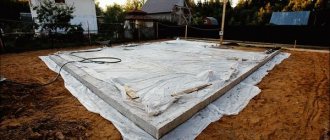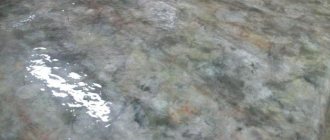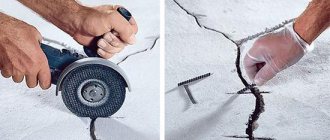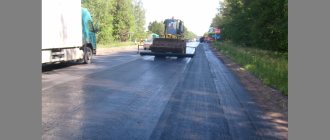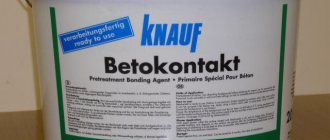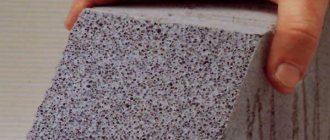When constructing any construction project, it is impossible to do without performing concrete work, be it installing a screed, blind area or pouring a foundation. This type of work involves laying a concrete mass - an artificial building material obtained from a mixture of cement, filler and water. The brand and type of cement and filler used to prepare the solution determine the purpose and scope of its application. For example, mixtures made on the basis of pozzolanic Portland cement are used in the construction of structures whose operation takes place in conditions of high humidity.
Types of concrete and types of work on its laying
Based on its properties, concrete can be divided into:
- prestressing - concrete that contains expanding cement or an additive that ensures expansion of the concrete during the hardening process;
- rapid-hardening concrete gains strength in a short period of time;
- highly functional concrete;
- decorative concrete is obtained by coloring, texturing, polishing, engraving, embossing and other methods to achieve certain aesthetic properties;
- draining concrete, which contains only coarse aggregate (the content of fine aggregate is minimized or absent altogether).
Also, according to a combination of characteristics, concrete can be classified into: heavy, fine-grained, light, cellular, silicate, heat-resistant and chemically resistant.
When constructing concrete and reinforced concrete structures, a number of interrelated processes are performed in accordance with SNiP:
- work on the manufacture and installation of formwork, stripping;
- reinforcement work, which consists of the manufacture and installation of reinforcement structures in the position specified by the project;
- concrete work, including the preparation of a concrete mixture, its transportation (in the case of preparing the mixture at a site other than the work site), supplying the solution to the installation site, directly laying the concrete and compacting it, as well as maintaining and caring for the concrete during its hardening.
Each type of work, according to SNiP, has a number of features. For example, transportation of a ready-made concrete mixture should include measures to protect the concrete from exposure to precipitation and sunlight, delamination, and in winter also from freezing. And the preparation of a concrete mixture of a certain brand must be carried out in strict adherence to technology that ensures workability.
The concrete mixture is laid in horizontal layers over the entire area of the concreted area. In this case, all layers must have the same thickness, and work is carried out continuously in one direction with careful compaction.
In cases where conventional concreting methods are unsuitable or uneconomical, special ones are used: casting, separate concreting, underwater concreting, concreting in low temperatures or hot climates.
When laying the mixture by casting, superplasticizers - additives based on naphthalene sulfonic acid or melamine resin, which increase the mobility of the mixture. When carrying out work using this method, there is no need to distribute and vibrate the mixture, which reduces cement consumption.
When using separate concreting, coarse aggregate is first placed in the formwork, and then a cement-sand mortar is placed to fill all the voids. This method is used when concreting in conditions of abundant groundwater.
Underwater concreting is used in construction, repair and restoration work of underwater parts of structures. There are the following concreting methods: using a vertically moving pipe, laying in bags, using the rising solution method, laying in bunkers.
When building in winter, it is necessary to create such a regime so that by the time the concrete freezes, it acquires critical strength. Such work is carried out using non-heating methods and using artificial heating. The first type includes the thermos method and the addition of antifreeze additives. Artificial heating includes electrical heat treatment of concrete, heating with hot air, steam, and the use of heating formwork or greenhouses.
Pouring concrete on the ground
The easiest way to install a subfloor indoors is to concrete the base. We'll tell you how to properly pour concrete over the ground in a garage, indoors or outdoors.
General rules for concreting a site - the base must be dense and well compacted. The soil should not “breathe” - rise in frost, fall in summer. The groundwater level is above 4 m.
Concrete floor in a heated room
A layer of sand is poured onto the prepared surface, compacted, and spilled with water to compact it. Gravel or crushed stone is poured on top to a height of 8 cm. A reinforcing mesh is laid on plastic bosses, and concrete is poured in a layer of 5 cm. This is a subfloor, but not a screed.
After 2 weeks, a waterproofing membrane, solid insulation boards, and a waterproofing layer are installed. Now it is necessary to measure the horizontal position, install the reinforcing mesh and pipe heating system and perform the screed under the cladding.
Concreting an open area
Concreting a yard is easier than a room, but in order for the monolith to stand for a long time, without cracks, it is necessary to perform the following operations:
- Remove the top fertile layer of soil, add clay, compact it with the addition of crushed stone.
- Install drainage - 5 cm of compacted sand and 6-8 cm of gravel without compaction.
- Install formwork from scrap materials with a smooth inner wall.
- Cover the area with waterproofing material, in the form of a bathtub, overlapping the formwork.
- Lay a reinforcing mesh of wire with a cross-section of 6 mm, cells from 100x100 mm, on the crushed stone. Tie the frame and secure it.
- Install beacons for the upper filling level. You can use profile pipes and provide a slope for drainage of rain and flood waters. Mark expansion joints using strips of plywood. They should be removed after 2 days.
- M200 concrete is used for pouring. The entire prepared site is concreted at the same time. Excess mixture is removed after 1-2 days using a plaster rule and a straight lath. The surface should be covered with film and periodically wetted.
After 2 weeks you can walk around the yard and paths.
Concreting a garage floor
Unlike a heated room, the floor in the garage is concreted immediately as a working surface capable of taking dynamic and shock loads.
Here the zero level should coincide with the level of the garage door. A slight slope is provided to allow water to drain. A 5 cm layer of sand, 10 cm of crushed stone and 10 cm of concrete with reinforcement are laid on the ground. The concrete floor is installed floating, not connected to the walls. The bottom layer of waterproofing is made in the form of a concrete bath, with an overlap on the walls. For reinforcement, two offset meshes are laid on the brick halves. The wire cross-section is 7-8 mm, the cell size is 15x15 cm, suitable for light transport. 2 layers of mesh are connected to each other. Profiled pipes or strips are used as beacons. Next, the concrete screed is poured, as in a warm house, but M250 grade concrete is used.
Types of concrete work
Existing types of concrete work
Preparation of the solution
To provide the foundation with high strength, you should prepare a concrete solution with high quality characteristics. Cement is purchased in grades no lower than M-200. To prepare it you will need:
- crushed stone;
- cement;
- sand;
- water;
- if necessary, plasticizers that can improve the quality of concrete.
To make the mixture, you need to pour dry ingredients into a concrete mixer: three parts sand, one part cement and five parts crushed stone. The dry ingredients are mixed and poured with water; there should be enough water to obtain a solution with a consistency reminiscent of thick sour cream. Mixing the components of the mixture in a concrete mixer will take about five minutes; if it is not possible to purchase such equipment, then the working mixture is diluted in a large container. But then it is worth considering that preparing the solution without special equipment will take a lot of time.
You need to make a concrete mixture immediately before starting to pour the foundation.
Return to contents
Requirements for the quality of concreting
The following requirements are imposed on finished reinforced concrete and concrete structures of all types in accordance with SNiP:
- operational safety;
- serviceability;
- durability;
- additional requirements specified in the design documentation.
The quality of the finished structure depends on the quality of the materials used and compliance with technological regulations at all stages of construction. In order to ensure that SNiP requirements are met, control is carried out at all stages of concreting:
- acceptance/storage of building materials;
- execution and installation of reinforcement structures;
- production and installation of formwork;
- preparatory measures for the base and formwork surfaces for concreting;
- the process of preparing and transporting concrete mixture;
- work on laying and compacting the mortar, as well as caring for it during hardening.
During the preparation of a concrete mixture, the accuracy of the dosage of components, the duration of the mixing process, as well as the density and plasticity of the mixture are checked. During transportation, the mixture should not separate, set or lose mobility.
At the reinforcement , in addition to the quality of the reinforcing bars, the quality of welding connections and the correct placement of reinforcement in the structure are checked. When constructing formwork, special attention is required to the correctness of its installation, the tightness of butt joints, as well as the location of the formwork relative to the reinforcement structure.
Before directly laying the mortar , the quality of the lubricant and the cleanliness of the formwork surfaces must be checked; during the laying process, the height from which the mixture is dropped, the duration and uniformity of compaction are strictly observed. The presence of voids and delamination is strictly unacceptable.
Concrete work carried out in winter requires special control measures. During their production, the absence of ice when feeding unheated aggregates into the concrete mixer, the temperature of the supplied water, the concentration of salts and the temperature of the solution at the outlet of the mixer are checked.
Assembly of formwork structures
Installation of wall panel formwork
The implementation of monolithic work begins with the installation of formwork, which, in essence, is a form for pouring concrete mixture. When constructing foundations, this stage may be preceded by marking, excavation and filling of crushed stone-sand cushion.
For formwork installation the following can be used:
- edged boards and timber;
- plywood, particle boards and other similar materials;
- sheet metal;
- polystyrene foam boards, which later remain as insulation;
- standard factory-made panel elements;
- foundation blocks, slabs, pipes and more.
The best materials for installing formwork should not absorb moisture and ensure the maximum possible tightness of the structure. Loss of moisture from the concrete mixture reduces the quality of concrete and reduces its grade. Therefore, it is recommended to cover wooden and other moisture-absorbing surfaces with plastic film.
Standard panel formwork is a structure made of a metal frame with a sheet of plywood laminated on one side attached to it. The connection of the shields into a single structure is carried out using special elements and metal racks.
Installation of floor formwork on telescopic racks
When installing the formwork structure, it is necessary to ensure its strength and ability to withstand the weight pressure of the poured concrete mixture. Destruction of formwork during monolithic work can lead to serious financial costs and delays in construction.
Documents regulating concrete work
The main documents regulating the performance of concrete work are construction norms and rules (SNiP), which determine the list and requirements for the materials used, the sequence of concrete work and the requirements for them.
Thus, according to SNiP 3.03.01−87, the use of a natural mixture of gravel and sand that is not dispersed into fractions is prohibited for preparing a concrete mixture. To ensure that a high-quality solution is prepared, the components are dosed by weight and not by volume. The SNiP for concrete work clearly defines the order of laying the components for preparing various types of solutions and the duration of their mixing.
The SNiP document also regulates the use of various types of concrete (heat-resistant, alkali- and acid-resistant, etc.) and methods of its installation, including work in conditions of high and low temperatures, as well as methods of transportation, control, acceptance and requirements for finished concrete structures .
All activities for performing concrete work must be reflected in plan (WPP).
Failure to comply with regulated standards and SNiP requirements for the quality of materials and performance of work, as well as deviations from the project, leads to a deterioration in the quality of the work performed and, accordingly, the safety and service life of concrete structures.
What materials and tools are needed?
To build a concrete foundation, you will need the following tools and materials:
- welding machine;
- grater;
- pegs;
- steel rods;
- concrete mixer or empty container for preparing the solution;
- shovel;
- rope or cord for marking;
- hoe;
- building level;
- cement;
- sand;
- crushed stone;
- water;
- beams for the construction of formwork.
Return to contents
Stages of installing a concrete floor
Concrete floors are laid using a certain technology, which should not be ignored even in small details. Only strict adherence to the rules and regulations, the correct selection of components will allow you to create a durable and reliable floor, resistant to stress and sealed, which will serve for a long time.
The main stages of creating a concrete floor:
- Careful and proper preparation of the base.
- Laying waterproofing, thermal insulation (optional).
- Marking, laying beacons.
- Reinforcement.
- Filling the floor along the beacons.
- Proper screed care.
- Performing surface finishing.
- Cutting seams, mandatory sealing.
Filling the floor can be done over the old coating or over the ground. If we are talking about an old base, then it is important to properly prepare it for the new layer - clean it, eliminate cracks, process everything and level it. Pouring on the ground is a more labor-intensive process, but more reliable. They are carried out where it is dry enough, in the format of layer-by-layer laying of different materials.
A standard concrete floor on the ground looks like this: compaction and cleaning of the base, backfilling with a cushion of sand and crushed stone (expanded clay), laying waterproofing, pouring a rough concrete screed, installing steam/thermal insulation, reinforcement, pouring the finishing screed.
What materials are needed for arranging a concrete screed: cement grade M400/M500, sifted quarry sand, gravel/crushed stone of the optimal fraction (the choice depends on the thickness of the layer), expanded clay (for additional thermal insulation), fiberglass (additional reinforcement, not always used), reinforcing mesh made of steel with a cell size in accordance with the thickness of the screed and a cross-section of 6-8 millimeters (you can take fiberglass, steel rods), knitting wire, galvanized metal profile (beacons), polyethylene film.
Necessary tools: a powerful construction mixer or concrete mixer, vibrating screeds, usually a building level, a ruler, smoothers, clean containers, spatulas, trowels, tamping machines, hammer drills, jackhammers. If you plan to make a floor from a semi-dry screed, then for mechanical filling you will need mortar pumps and pneumatic blowers.
Features of winter concreting and masonry work
To understand how antifreeze additives work and what are the advantages of using them, you need to imagine what happens to concrete or masonry mortar if you build in winter.
Kirill Lebedev Technical specialist at SIKA
At subzero temperatures, the water contained in concrete or masonry mortar begins to freeze. As a result, ice crystals form. Moreover, when water freezes, it expands (by approximately 7-9%) and destroys the structure of concrete, which has not yet achieved the required grade strength. Those. the process of cement hydration, which is only possible at positive temperatures, stops. Accordingly: concrete or mortar does not harden, but freezes.
If in this state the foundation or masonry “went into winter,” this will lead to dire consequences. Frozen water, not having time to fully react with the astringent components of the mixture, turns into a liquid state again with the onset of a thaw. Although the chemical process of interaction between cement grains and water continues, the destroyed structural bonds in concrete are not completely restored. In addition, water, freezing around the metal reinforcement (the colder zone during concreting), forms an ice film, increases in volume and, under pressure, squeezes the cement gel from the reinforcement frame.
As a result, the grade strength of concrete is significantly reduced (about 50% of the calculated value). Also, due to internal stresses and shrinkage, cracking of the foundation structure may occur with a complete loss of bearing capacity.
If, for example, facing bricks are laid at subzero temperatures, then the mixture, due to the small layer and additional, rapid cooling when interacting with cold stone, quickly freezes. Its plasticity is lost, horizontal seams remain insufficiently compacted. The mixture is actually held together by the ice.
The so-called is based on this method. freezing masonry method, when it is planned that when the mixture thaws in the spring, the hardening process of the solution will continue. But the risks outweigh the benefits. When thawing, the masonry mortar, which does not yet have sufficient strength, shrinks due to the weight of the overlying masonry. Uneven shrinkage occurs, leading to loss of stability and further destruction of the lining.
Construction of working seams
Concreting seam.
It is recommended to pour foundations with concrete mortar without long breaks. Laying subsequent layers of the mixture should not take more than three hours. But often it is not possible to adhere to such rules and then it is necessary to organize the construction of working seams.
Working joints are the boundary between the poured concrete layers, and in their manufacture the technological process should be followed. If the technology is violated, then the foundation for buildings and structures will not acquire the necessary quality characteristics.
When installing working seams, it is important to achieve maximum adhesion of the concrete layers to the seams. To do this, the hardened surface should be prepared for subsequent work. The surface is cleaned of dust, snow, debris or water. Next, remove the cement laitance that forms on the hardened mortar. Cement laitance forms a film that has a loose, fragile structure, which leads to a decrease in the adhesion of the solution to the hardened layer. Film removal is carried out using a water or air jet supplied under high pressure. In this way, the film is removed from the hardened concrete surface. In addition to removing the film with a high-pressure jet, milling machines are used. The cement film can be destroyed with acid, which is applied to the hard layer and left for several hours.
Laying subsequent layers of concrete mortar begins only after removing the film from the hardened surface. Next, the seams are insulated and waterproofed, which will prevent premature destruction of the foundations of buildings and structures.
Return to contents





